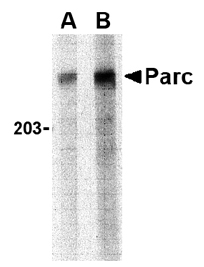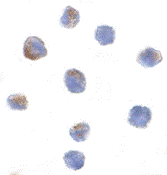Catalog# :3171
The continued localization of p53 to the nucleus is essential for its function as a tumor suppressor. PARC, a large, Parkin-like ubiquitin ligase has recently been identified as a cytoplasmic anchor protein in p53-associated protein complexes. In the absence of stress, PARC inactivation results in nuclear localization of p53 and activation of p53-dependent apoptosis, while overexpression of this protein promoted cytoplasmic sequestration of p53. Surprisingly, PARC knockout mice were viable and exhibited no obvious phenotype, suggesting that other proteins, such as the highly related cullin family of E3 ubiquitin ligases, may perform similar functions in the absence of PARC. Additionally, it has been suggested that p53 binding to PARC may serve to control PARC function.
Additional Names : PARC, p53-associated parkin-like cytoplasmic protein, UbcH7-associated protein 1
 Description
Description
Left: Western blot analysis of PARC in Daudi lysate with PARC antibody at (A) 1 and (B) 2 µg/ml.
Below: Immunocytochemistry of Parc in Daudi cells with Parc antibody at 1 µg/ml.
Other Product Images
 Description
DescriptionLeft: Western blot analysis of PARC in Daudi lysate with PARC antibody at (A) 1 and (B) 2 µg/ml.
Below: Immunocytochemistry of Parc in Daudi cells with Parc antibody at 1 µg/ml.
Other Product Images
 Source :PARC antibody was raised against a 17 amino acid peptide from near the carboxy terminus of human PARC.
Source :PARC antibody was raised against a 17 amino acid peptide from near the carboxy terminus of human PARC.Purification : Affinity chromatography purified via peptide column
Clonality and Clone : This is a polyclonal antibody.
Host : PARC antibody was raised in rabbit.
Please use anti-rabbit secondary antibodies.
Application : PARC Antibody
Tested Application(s) : E, WB, ICC
Buffer : Antibody is supplied in PBS containing 0.02% sodium azide.
Blocking Peptide :Cat.No. 3171P - PARC Peptide
Long-Term Storage : PARC antibody can be stored at 4ºC, stable for one year. As with all antibodies care should be taken to avoid repeated freeze thaw cycles. Antibodies should not be exposed to prolonged high temperatures.
Positive Control :
1. Cat. No. 1224 - Daudi Cell Lysate
Species Reactivity : H, M
GI Number : 24307991
Accession Number : NP_055904
Short Description : a cytoplasmic p53 binding protein
References
1. Nikolaev AY, Li M, Puskas N, et al. Parc: a cytoplasmic anchor for p53. Cell 2003; 112:29-40.
2. Skaar JR, Arai T, and DeCaprio JA. Dimerization of CUL7 and PARC is not required for all CUL7 functions and mouse development. Mol. Cell. Biol. 2005; 25:5579-89.

No comments:
Post a Comment